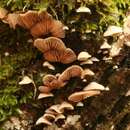en
names in breadcrumbs


Crepidotus epibryus, is a species of saprophytic fungi in the family Crepidotaceae. It is commonly known as grass oysterling in the United Kingdom and is seen there in late summer and autumn.[3]
Common to Britain and Ireland, also occurs in Europe and in North America.
Crepidotus epibryus, is a species of saprophytic fungi in the family Crepidotaceae. It is commonly known as grass oysterling in the United Kingdom and is seen there in late summer and autumn.
Crepidotus epibryus, es una especie de hongo, del orden Agaricales, de la familia Crepidotaceae, perteneciente al género Crepidotus.
El píleo tiene la forma de un pétalo puede medir hasta 1 centímetros de diámetro y 3 milímetros de espesor, es aterciopelado, no desarrolla tallo, su color es blanquecino, crece en los tacones de madera y troncos muertos en los meses de verano en Estados Unidos (Colorado, Míchigan y Tennessee) y en Europa. El sabor y el olor es suave.[1]
Crepidotus epibryus, es una especie de hongo, del orden Agaricales, de la familia Crepidotaceae, perteneciente al género Crepidotus.
Capel fin a 1,5 cm, a rognon, bianch setos. Lamele pòch s-ciasse, da bianche a crema.
A chërs ëdzora a detrì d'erba.
![]() A venta mai mangé un bolè trovà se un a l'é nen un bon conossidor dij bolè!
A venta mai mangé un bolè trovà se un a l'é nen un bon conossidor dij bolè!
Sensa anteresse alimentar.
Capel fin a 1,5 cm, a rognon, bianch setos. Lamele pòch s-ciasse, da bianche a crema.
AmbientA chërs ëdzora a detrì d'erba.
Comestibilità![]() A venta mai mangé un bolè trovà se un a l'é nen un bon conossidor dij bolè!
A venta mai mangé un bolè trovà se un a l'é nen un bon conossidor dij bolè!
Sensa anteresse alimentar.
Crepidotus epibryus (Fr.) Quél. 1888 (1872?)
Синонимылат. Crepidotus epibryus — вид грибов рода Крепидот (Crepidotus). Известен также под названием плевроте́ллюс мохово́й (Pleurotellus epibryus).
Плодовые тела шляпочные, вначале имеют рудиментарную ножку, затем сидячие, прикрепляются к субстрату боком или верхней частью.
Шляпка диаметром 0,2—2,5 см, в молодом возрасте лопастная, затем становится почковидной, округло-раковиновидной, выпуклая. Край подвёрнутый, рубчатый. Поверхность войлочно-опушённая, белая, не изменяет цвет при высыхании.
Пластинки от широкоприросших до свободных, частые, шириной 1—2 мм, от белые или желтоватые, затем буроватые. Имеются пластиночки.
Мякоть белая, тонкая, без запаха и выраженного вкуса.
Остатки покрывал отсутствуют.
Споровый порошок палёво-охряный. Споры неамилоидные, ацианофильные, от удлинённо-цилиндрических до веретеновидных, размерами 6,5—10,5×2,5—3,5 мкм, гладкие.
Хейлоцистиды бесцветные, цилиндрические часто извилистые, разветвлённые, размерами (20) 30—60×2—7 мкм.
Гифальная система мономитическая, гифы без пряжек тонкостенные, диаметром 2—4 мкм. Тип пилеипеллиса — триходермис, с возрастом переходящий в кутис, образован извилистыми гифами.
Трама пластинок субрегулярная.
Базидии четырёхспоровые, булавовидно-цилиндрические, размерами 15—25×2—7 мкм, без пряжки в основании, имеют центральную перетяжку.[2]
Сапротроф на мелких остатках древесины, побегов мхов, лесной подстилке, отмерших травах, вызывает белую гниль. Известен в Европе, Северной Америке, Южной Америке (Бразилия), встречается на остатках клёна (Acer), тополя (Populus), пихты (Abies), туи (Thuja), ясеня (Fraxinus), сосны (Pinus), злаков (Poaceae) и других растений.[2][3][4][5]
лат. Crepidotus epibryus — вид грибов рода Крепидот (Crepidotus). Известен также под названием плевроте́ллюс мохово́й (Pleurotellus epibryus).